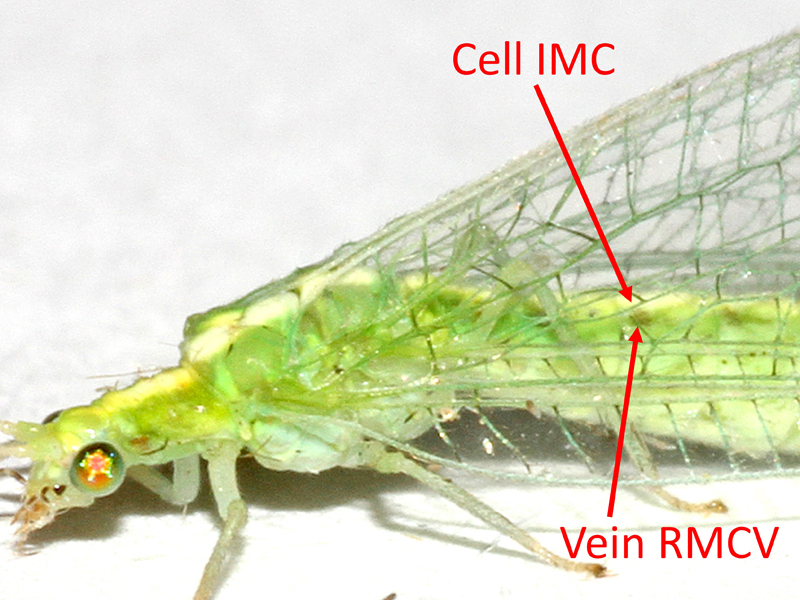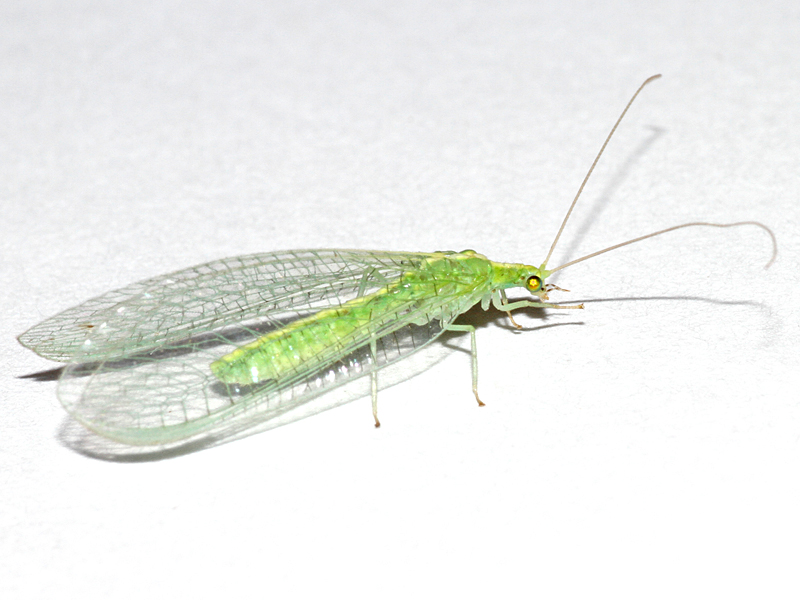Cunctochrysa albolineata
A common species. My records span between late June and late September with a strong peak in late July.
This is one of a group of relatively unmarked green lacewings that require examination of the hairs on the wing to identify. Firstly eliminate the Chrysoperla spp. (see Chrysoperla carnea for details - and remember, best to check both wings in case of abnormalities). Also check there is no black spot between the antennae and the second segment of the antennae is green. You are then left with the Nineta species, the two of which that occur in Norfolk, flava and vittata, are normally large (forewing >= 16mm) and have either a long swollen basal segment of the antennae or a concave costal edge to the forewing.
Like the Chrysoperla species, Cunctochrysa albolineata usually has a distinct pale creamy stripe down the thorax which is less distinct or absent on the otherwise similar Apertochrysa flavifrons and Chrysopidia ciliata. It's best to check the hairs along the forewing costa to be sure though - these are long and stick out on those two species but are short and lie flatter, close to the costa, on Cunctochrysa (although often not as flat as illustrated in Plant). Also the hairs on the costal cross-veins are shorter (especially compared to ciliata) and all point backwards (a few often point forwards on flavifrons).
Cunctochrysa albolineata is harder to tell from Cunctochrysa cosmia (formerly Cunctochrysa bellifontensis). The 2014 edition of Neuro News announced that Cunctochrysa bellifontensis is "is widely regarded as a form of C. albolineata and not as a full species" and as such excluded it from the checklist of British Neuropterida. However, the 2021 edition (there were none in between) reinstates it as a full species (renamed C. cosmia).
Plant (1997) separates albolineata (and Chrsysopidia ciliata) from cosmia (and Apertochrysa flavifrons) by the colour of the basal costal vein and the cross-vein between the radial and subcostal veins in the forewing. The former is entirely dark in cosmia/flavifrons and partly or entirely pale in albolineata/ciliata, whereas the latter is usually pale in cosmia/flavifrons and usually black or at least darkened in albolineata/ciliata. I have struggled with this couplet, with many individuals not seeming to conform to both characters, resolvable only by taking "usually" to be "not this time" or else requiring "darkened" to be so slight as to be easily missed or "partly" to be extremely minimally. However, whether easily or with a struggle, all my Cunctochrysa specimens checked against these criteria were albolineata and not cosmia. Unfortunately, from 2017 to 2021 I was labouring under the impression that the two were the same species so did not always check for these differences, and I'm not sure which ones I did or didn't check - as a consequence I should now treat all my albolineata records from that period as Cunctochrysa aggregate except those which were photographed sufficiently clearly to show the relevant characters. As cosmia has not yet been confirmed in Norfolk it's very likely that they were all or at least mostly albolineata.
In this photo you can see the position of vein RMCV proximal to (i.e. head-side of) the apex of cell IMC, the key feature for eliminating Chrysoperla species.


Cunctochrysa albolineata, North Elmham (Norfolk, UK), 23rd July 2016

Cunctochrysa albolineata, North Elmham (Norfolk, UK), 21st August 2016
.JPG)
.JPG)
2x Cunctochrysa albolineata, North Elmham (Norfolk, UK), 24th August 2016
 (1).JPG)
 (2).JPG)
Cunctochrysa albolineata, North Elmham (Norfolk, UK), 24th July 2016
.JPG)
Cunctochrysa albolineata, North Elmham (Norfolk, UK), 27th August 2016
I initially thought the following lacewing was a Chrysoperla carnea agg. as vein RMCV was well past the apex of cell IMC on the forewing I initially checked. But, as I always do with carnea agg., I checked the abdomen to rule out pallida, and to my surprise it did not resemble any Chrysoperla abdomen I have seen before, with a long triangularly-pointed chin and no lip. The lacewing was a little dried by now so I cleared the abdomen to make sure, and yes, I was right - and the internal apparatus didn't match carnea either (I had one handy to compare it with). The wing-venation and other characters didn't fit Peyerimhoffina gracilis, so at this point - I should have done this earlier - I checked the other wing. The other wing didn't have a cell IMC at all. I looked back at the first wing and I think cell IMC is smaller than usual, which would bring its apex forward in relation to vein RMCV - this insect clearly had abnormal wing venation. Other characters checked out for Cunctochrysa albolineata, so I presume that's what it is. I've never needed to check the internal aparatus of albolineata before and had to wait to the following season before I caught another one to compare it to, but it did indeed look the same (although I don't know how similar other closely related species like cosmia are in this respect).
, North Elmham, 31-Jul-21 (A) (1).jpg)
, North Elmham, 31-Jul-21 (A) (3).jpg)
, North Elmham, 31-Jul-21 (A) (4).jpg)
, North Elmham, 31-Jul-21 (A) (7).jpg)
presumed Cunctochrysa albolineata with abnormal wing venation showing fore and hind wings from one side, internal aparatus and part of other forewing, North Elmham (Norfolk, UK), 31st July 2021
Following notification that cosmia and albolineata are again treated as different species I paid more attention to the basal costal cross-vein and the vein between the subcostal and radial veins, as the darkness of these is where Plant (1997) differentiates the two taxa. If I understand Plant correctly, the basal costal cross-vein is more important here - dark on cosmia and pale or at least partly pale on albolineata. The description of the other vein is caveated with "usually" for both ways, so I assume less reliable. Both of the two males below showed both veins pale. I'm pretty sure this is how I've found them previously too, but will check this more systematically from now on.
 (1).jpg)
 (2).jpg)
 (3).jpg)
 (4).jpg)
 (5).jpg)
 (6).jpg)
 (7).jpg)
Cunctochrysa albolineata showing forewing with close-ups of base and middle-third costa, abdomen tip and cleared aparatus from abdomen tip, North Elmham (Norfolk, UK), 16th June 2022
 (1).jpg)
 (2).jpg)
 (3).jpg)
 (4).jpg)
 (5).jpg)
 (6).jpg)
second Cunctochrysa albolineata showing forewing with close-ups of base and middle-third costa, abdomen tip and cleared aparatus from abdomen tip, North Elmham (Norfolk, UK), 16th June 2022
The more I check the more it seems that the normal colour of vein Sc-R is green, with narrow dark edges.
, North Elmham, 11-Jul-22 (A) (1).jpg)
, North Elmham, 11-Jul-22 (A) (3).jpg)
, North Elmham, 11-Jul-22 (A) (4).jpg)
, North Elmham, 11-Jul-22 (A) (6).jpg)
female Cunctochrysa albolineata showing forewing with close-ups of base and middle-third costa and vein Sc-R, North Elmham (Norfolk, UK), 11th July 2022
, North Elmham, 11-Jul-22 (B) (1).jpg)
, North Elmham, 11-Jul-22 (B) (2).jpg)
, North Elmham, 11-Jul-22 (B) (3).jpg)
second female Cunctochrysa albolineata showing both forewings' veins Sc-R, North Elmham (Norfolk, UK), 11th July 2022
, North Elmham, 11-Jul-22 (C) (1).jpg)
, North Elmham, 11-Jul-22 (C) (2).jpg)
, North Elmham, 11-Jul-22 (C) (3).jpg)
, North Elmham, 11-Jul-22 (C) (4).jpg)
male Cunctochrysa albolineata showing basal costal cross-veins and vein Sc-R, the other forewing's vein Sc-R and mid costa of forewing, North Elmham (Norfolk, UK), 11th July 2022
The hairs along the costa look a little longer and more erect on this one, though not as long as on Apertochrysa flavifrons or Chrysopidia ciliata. Taking a combination of characters it was clearly another albolineata.
, North Elmham, 11-Jul-22 (D) (1).jpg)
, North Elmham, 11-Jul-22 (D) (2).jpg)
, North Elmham, 11-Jul-22 (D) (3).jpg)
, North Elmham, 11-Jul-22 (D) (4).jpg)
second male Cunctochrysa albolineata showing both forewings' veins Sc-R and mid costa of forewing, North Elmham (Norfolk, UK), 11th July 2022
This one did have a more darkened vein Sc-R.
 (1).jpg)
 (2).jpg)
Cunctochrysa albolineata, Hoe Rough (Norfolk, UK), 23rd July 2023
.jpg)
.jpg)
2x Cunctochrysa albolineata, North Elmham (Norfolk, UK), 17th July 2022
 (2).jpg)
Cunctochrysa albolineata, North Elmham (Norfolk, UK), 17th September 2023
This larva seems to be a good match for Cunctochrysa albolineata, but references on lacewing larvae are 100 years old and incomplete, so I am not confident about this ID.

probable Cunctochrysa albolineata, North Elmham Cathedral Meadows (Norfolk, UK), 3rd September 2019
